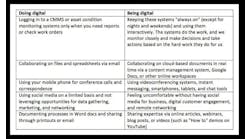Could the Fourth Industrial Revolution create a manufacturing renaissance?
By Chad Moutray, director of the Center for Manufacturing Research at the Manufacturing Institute & Jeff Sorensen US Industrial Products Leader for PwC
The fourth industrial revolution—the melding of the physical and digital worlds—has been on a gradual march for some time. Yet, recently, it seems to have reached a healthy jog.
Indeed, 4IR tech is changing how we produce things, track the supply chain, add intelligence to our products, and enlist the kind of labor force we need to carry all of this out. Part of the reason for this is that core 4IR technologies (from collaborative robotics to the Industrial Internet of Things to artificial intelligence, 3D printing, and
virtual/augmented reality) are becoming less expensive, more powerful and easier to deploy. Consider, for instance, that the number annual of shipments of industrial robots in the US has steadily risen to 46,000 in 2017, up from 17,000 in 2010.
To get a clearer picture of how 4IR adoption is playing out, PwC and The Manufacturing Institute surveyed about 100 US manufacturers. As our report indicates, while most manufacturers recognize the potential value 4IR technologies can offer, many are still learning how and where to invest to capture productivity and bottom-line returns—4IR’s “golden fleece.”
Crossing from ad hoc pilots to full scale-up
In fact, many manufacturers still inhabit the awareness and pilot phases in implementing 4IR tech. Nearly half reported they’re in the early stages of a smart-factory transition (awareness, experimental, and early adoption phases). Meanwhile, 31% report that adopting an IoT strategy in their operations is “extremely critical” while 40% report that it’s “moderately critical.” Of those using metrics to track the success of 4IR technology adoption, the areas in which they’re seeing success include productivity gains, reduced labor costs, new revenue streams from IoT-related products and services, and reduced injuries and greater workforce retention.
A challenge for many companies at the low end of the technology adoption curve, however, is to move from ad hoc pilots to coordinated, end-to-end digital operations innovation. Doing so, however, cannot be achieved overnight. Current investments in 4IR are incrementally laying the groundwork for a digital-operations transformation for long-term goals including improvements in operations (productivity, quality, reliability, responsiveness); greater visibility into performance, status, and operating risks and gaining a competitive edge in through differentiated, connected product and service offerings; and improved customer service.
While such gains may not be immediate, the manufacturers that fold 4IR investment into their overall business strategy and prioritize where to invest may be more likely to pull ahead and, at the same time, guard themselves against economic headwinds.
Yet, given the uneven rates of adoption and measurable indicators of success, manufacturers are, by and large, forging ahead. Of manufacturers investing in 4IR technology, more than half plan to increase their investments by up to 25% over the next year against the previous year. For example, 80% of manufacturers reported they will have deployed sensors in operations over the next three years and about 60% will have embedded smart sensors in products in the next year.
Clearly, these are signs that these companies recognize that moving forward or establishing themselves as early adopters could lead to a competitive advantage.
4IR: a shot in the arm for the US manufacturing workforce?
As with previous industrial revolutions, more manual and physical labor roles (especially the repetitive or dangerous ones) will likely be replaced by automation technology. However, our survey suggests that some manufacturers see now as the time to create more value from their existing employees through upskilling and reskilling, as new types of jobs are created. In fact, only 19% of manufacturers think the biggest impact of robotics over the next five years will be worker replacement. The bulk of respondents note that robotics can create new job opportunities triggered by rising demand for engineering talent as well as for managers of the robotics workforce.
As the US manufacturing workforce add new members, companies will be able to train the new hires around 4IR. And there are a lot of them. Since 2011, the manufacturing sector has added 1.2 million workers, totaling 12.8 million as of April 2018.
Continued 4IR adoption and this new generation of workers (especially digital natives) could accelerate 4IR scale-ups across organizations and more rapid development of digital products and services.
Our survey suggests that most manufacturers are planning to upskill and reskill their current employees on using and managing new technologies. In addition, manufacturers see a need to expand their workforce to include new employees—in part by identifying and recruiting talented science, technology, engineering, and mathematics students, and by providing outside training at community colleges and through technology vendors in order to prepare potential new workers for roles in modern manufacturing.
Think of 4IR as a strategy, not a tech solution
There are a few main take-ways for manufacturers to consider as they build out their 4IR initiatives in ways that are strategic and tethered across their organizations and to their long-term business goals.
- Start with the outcomes that matter to the business. It can be tempting to go full steam ahead and embrace 4IR technologies and build new capabilities, but the organizations that do so without first articulating their business needs will likely find that they invest heavily but fall short of expectations. By first focusing on desired business outcomes or identifying gaps in their operations, supply chain, or product portfolio, manufacturers will let their business strategy guide their 4IR investments, rather than the other way around.
- Think in the context of both growth and contraction scenarios. 4IR can help manufacturers maintain productivity in the face of a downturn, but doing so requires a strategic understanding of a company’s vulnerabilities and how to address them. For example, during a growth cycle, many companies have deployed 4IR innovations to create capacity (cost and CapEx avoidance); however, in a slow-down, the aim might be market-share expansion and price protection, with 4IR innovations implemented to increase operational flexibility and responsiveness or product innovation (for greater customer stickiness and new revenue streams).
- Look outside of the organization to scale beyond the pilot phase. Ad hoc efforts can help companies identify and develop business cases within the company; however, when the ultimate goal is end-to-end smart digital operations and strengthening advanced analytics capabilities, for example, manufacturers need to consider the full technology stack. This will require identifying partners and vendors in the 4IR ecosystem and building an architecture that enables scaling. For some smaller manufacturing companies, even simply identifying technologies and requirements will be a daunting task.
- Prepare the workforce for 4IR. 4IR brings with it an opening of new skills that are in high demand. Manufacturers can get ahead of a potential talent shortage and retain employees by focusing on training, both in-house and outside the company.
Separating the hype from reality. Manufacturers are seeking to balance 4IR hype and reality. And most acknowledge that sitting back and waiting for the inevitable may not be an option. The road may be longer than the hype implies, but preparing for and embracing change is a muscle many of today’s manufacturers are ready to flex.
Those that can build on their ad hoc pilots and prioritize investments and strategies with their long-term, desired business outcomes will be better positioned to create lasting value for their organizations.


